Content [show]
Table of contents:
- Growing a coffee tree from seeds
- Growing a coffee tree from cuttings
- Plant care
Houseplant fans started growing coffee trees at home many years ago. So how to grow a coffee tree at home? These plants are quite beautiful, and the aroma leaves no one indifferent. You can even enjoy a coffee made from home grown fruits. You can collect up to 500 g of fruits per year.
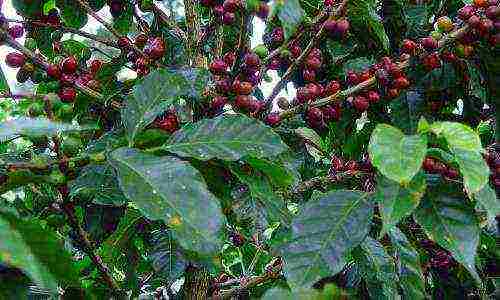
The coffee tree is a pretty beautiful plant, and the aroma will not leave anyone indifferent.
To grow a coffee tree indoors, Arabica or dwarf species are suitable.
When grown indoors, the tree can reach a height of up to 1.5 m.To take care of this plant, special efforts are not needed. Difficulties can only be caused by growing from seeds or cuttings. Vaccination is rarely used for reproduction.
Growing a coffee tree from seeds
To germinate coffee seeds, the soil for this plant must be defended for about 2 weeks. The soil should be loose with a slightly acidic reaction. Ideal for growing seeds of a coffee tree is the composition: 2 parts of turf soil, 1 part of sand, 1 part of peat. It is advisable to steam the soil or ignite it in an oven.
The ideal temperature for germinating seeds can be considered from 20 to 34 ° C. If the temperature in the room is lower, then you can equip a small greenhouse.
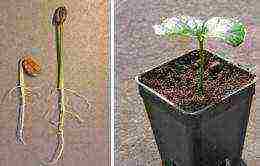
To germinate coffee seeds, the soil for this plant must be defended for about 2 weeks.
To be able to plant coffee seeds, you need to choose well-ripened fruits. The seeds must be planted immediately, because they quickly lose their ability to germinate. Green coffee beans are not suitable for germination.
Before planting, the grain must be prepared. They are peeled from the shell in order to accelerate germination. Then they are washed with water. Place the grains for 30 minutes. into a solution of potassium permanganate.
Prepare the pots as follows: 1 pot for 1 grain. Seeds are laid to a depth of 1 cm. The seeds should be laid out with the convex part up. Thanks to this, it will be easier for the sprouts to break through. When planting is done, the seeds need to be watered and covered with a glass jar.
A month later, leaves will begin to appear, protected by the seed coat. Until the leaves are free from the shell, the sprout should be in a very humid environment. When the leaves have shed their shell, the plant can be accustomed to a normal room environment. The jar is raised for 2 minutes, gradually this time is increased.

The ideal temperature for germinating seeds can be considered from 20 to 34 ° C.
After a while, nondescript brown spots will appear on the green stalk. The trunk will begin to dry out. You shouldn't be intimidated by this.This means that the trunk begins to take on the appearance of a tree. The crown will not form within 1 year. Only the trunk will grow. The next year, twigs will begin to appear from the buds on the sides. To form a lush crown, the branches will need to be pruned.
The disadvantage of this type of sprouting of a coffee tree is that the fruits will begin to appear only after 3-4 years.
Back to the table of contents
Growing a coffee tree from cuttings
If you plant several cuttings in 1 container, then you need to make sure that the leaves do not cover each other. The cuttings should be planted vertically to a depth of 25 mm. The stalk must be taken with 2 fingers and carefully inserted into the substrate so that the petioles of the 2 lower leaves are in the ground.
For better strengthening of cuttings in the ground at home, it is recommended to spill them with a solution of potassium permanganate.
For rooting, an important condition must be observed: there must be a humid environment near the ground cutting part. It can form if the container with the plant is covered with a polyethylene bag. But it is undesirable to close it strongly, because air must also flow.
For this purpose, a small hole can be made in the bag. Through it, you can spray the cuttings and moisten the leaves. Cuttings during germination should be under diffused light. Direct rays of the sun are undesirable. The soil temperature should be between +25 and 27 ° C. If the temperature is lower, the cuttings will root more slowly.
When the upper growth bud wakes up, it means that the cuttings are rooted. But you do not need to transplant the plant right away. It is necessary to wait for the first 2 leaves to appear. Then it will already be possible to dig out the cuttings. The root system should already be formed by this time.
When transplanting a cutting, it is undesirable to shake off all the peat, because it can later hurt for a long time. The mixture must be prepared as follows: 4 parts of turf, 2 parts of peat, 1 part of river sand. The pot should have a diameter of 120 mm. After planting, the cutting should be watered well. It is undesirable to put in direct sunlight. After a while, you will be able to see the first flower.
Back to the table of contents
Plant care
Plant feeding
For normal development, it is necessary to regularly feed the coffee tree with organic and mineral fertilizers. This must be done during the period of active growth in spring and summer. You can alternate fertilizers. In the spring, you can increase the amount of nitrogen, during flowering, you need to give a complex of minerals, phosphorus is necessary for the formation of fruits.
The rest of this plant comes in winter. The coffee tree will bloom with rather delicate white inflorescences, which consist of a large number of flowers with pointed petals. The smell will linger throughout the apartment.
Plant transplant
For the first 2 years, the tree is transplanted every year. This must be done in early spring, before the active growing season begins. Then the tree needs to be replanted less often - after a year. Given that the tree has a well-developed root system, you should take care of a sufficient depth of the planting container (pot), and each time you need to increase the diameter by 2-4 cm.
Naturally, each transplant will be accompanied by a change of soil. It is better to choose a ready-made one, suitable for growing tropical plants. The soil must be necessarily slightly acidic, rich in phosphorus, organic matter. It is good to arrange drainage at the bottom.
It is now known how to grow a coffee tree indoors. We wish you good luck in growing this tree and a good harvest!
Similar articles:
Already many plants have not learned how to grow our growers at home. From the most common compact flowers to tropical vines. Many people want to try growing something exotic and the coffee tree is ideal for growing at home.The types of this plant are different, but if we decide to grow, then the most suitable would be Arabica coffee and here's why:
- Grows up to 1 meter
- Looks like a bush
- Great for decorative applications
- Has a very pleasant smell
- Unpretentious care
One of the main advantages of the coffee tree is that you do not have to spend a lot of time caring for it, because Arabica is one of the most unpretentious plants. In our conditions, it is best to grow a tree from grain or cuttings. Then the coffee tree will best adapt to our habitat!
What types of coffee are advisable to grow at home, and where does real coffee grow?
In home gardening, only a few varieties of coffee trees are grown, among them Arabica coffee is especially popular. In its natural habitat, the coffee tree belongs to the madder family, which has more than 5 thousand species.
Of all the species, only 60 belong to coffee trees. Their distribution looks something like this: most of them grow in Africa, then Madagascar, Southeast Asia boasts ten types, and only 3 types of coffee grow on the island of Mauritius. Coffee trees found their second home in Brazil.
Coffee trees are very diverse, among their representatives in wildlife there are evergreens and shrubs, trees and tall varieties. All varieties of coffee trees are united by such a trait as the presence of a large dose of caffeine in the leaves and beans.
Massive coffee trees can grow only in equatorial countries, but it is difficult for them in hot tropical climates. For this reason, the plants are planted above 1.2 thousand meters above the sea.
Massive coffee trees can grow only in equatorial countries, but it is difficult for them in hot tropical climates. For this reason, the plants are planted above 1.2 thousand meters above the sea.

From the point of view of benefits, only a few types of coffee plants are important: Arabica coffee (the second name is Arabian) and Robusta. Useful crops can be Liberian and high coffee.
Arabian coffee
popular in home cultivation, represents a compact tree. The leaves are shaped like an elongated ellipse with a dark olive tint, glossy on the outside and pale on the inside. The inflorescences are small, about 2 centimeters in diameter, collected in a bunch. The size of the inflorescences directly depends on the growing conditions.
After opening, the flowers are fresh for only a few hours. But the buds open gradually, not at once. After the inflorescences have faded, the fruit ripens in the form of a berry, in ripe form it has a burgundy hue. Maturation occurs approximately 8 months after pollination. The paired fruits resemble round beans. This species reaches a height of up to 5 meters.
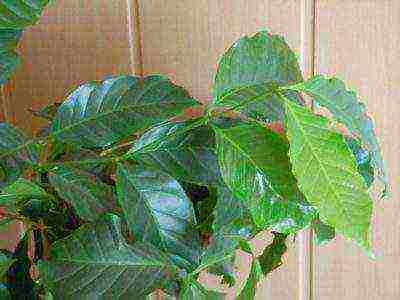
Dwarf coffee Nana
it is a neat plant, reaching a height of about 85 cm. The flowering is abundant and subsequently bears fruit at home. The desired design can be given to the tree by cutting and pinching the tops of the plant.

Liberian coffee
also grown indoors. Its ripe fruits have a scarlet or sunny slightly orange hue. The length of its leaves reaches up to 40 cm, and the height is regulated and the required shape is formed by trimming the crown of the plant. The inflorescence has a light shade and large fruits - berries.

Growing a coffee tree from a grain
To do this, you need ordinary coffee beans, which can be purchased in the store (only, of course, not roasted), or beans taken directly from the plant itself (suddenly your relatives or neighbors are happy owners of it). The cultivation method is almost the same as, for example, pomegranate or lemon - there are only a few characteristic features.
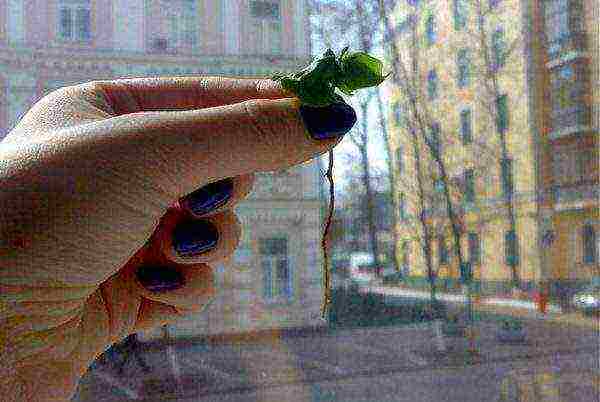
Since the shell of a coffee bean is very tough, hard and often interferes with the germination of the seed, it is necessary to carry out the so-called scarification before planting. This is the destruction of the shell by a chemical method (solution of hydrochloric or sulfuric acid), or mechanically - the grain must be cut or sawed.
The next step is to soak the grain in a stimulant solution. Well suited "Epin", "Kornevin", "Zircon" or others. It is imperative to plant the seed in soft, loose soil. The pot with the planted seed must be placed in a sunny place so that it germinates as soon as possible, the temperature must be at least 20 degrees.
- Seeds are cleaned of pulp and washed in a solution of potassium permanganate.
- The land for planting the seeds should be prepared ahead of time, two weeks in advance. The substrate must be mixed and left to "reach". The mixture includes well-steamed turf soil with sand and peat. Ash can be added.
- The seeds are placed on the ground with the flat side down, slightly pressed and buried by 1 cm. Everything should be well shed and covered with a transparent cover (glass, film).
- The container with the sown seeds is placed in a bright place, sheltered from the direct sun, the substrate humidity is kept constant and the ambient temperature is about 25 °. Ventilate daily.
- If the conditions are met, the seeds will hatch in a month.
- The appearance of the first pair of leaves can be the signal for the first transplant. Pots are chosen small, but deep, no more than 7 cm in diameter. You should carefully cover the seedlings from the sun.
- At the beginning of the lignification of the trunk, it may seem that it is drying out and cracking. In fact, the process is going fine. A brown color, spotting of the trunk may appear, but soon it takes on its usual appearance.
- Make the next transplant in a month, slightly increasing the capacity.
Growing a coffee tree from a cutting
If you find where to buy a stalk of a coffee tree, then it is better to use this planting method. A tree planted in this way will grow faster, and, therefore, yield faster. The second advantage of this planting method is that the tree will grow in width, not in height, as when planting a seed. Planting a stem of a coffee tree is very simple, there are no differences from other cuttings.
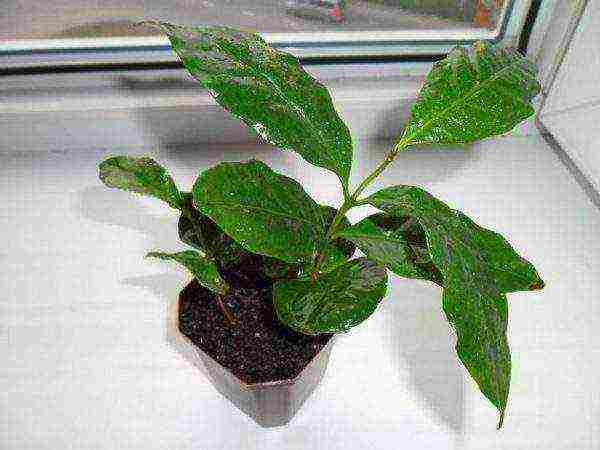
This method has its advantages:
- If all conditions are met, 100% rooting is achieved;
- All characteristics of the mother plant are preserved;
- Flowering may occur in the first year;
- Fruiting begins 2-3 years earlier than plants grown from seed;
- The fruits are more numerous and larger.
Caring for the coffee tree at home
How to properly land was described above. How to properly care for a coffee tree? Many amateur flower growers, who do not have sufficient personal experience in caring for indoor plants in general, not to mention a coffee tree in particular, draw information from very dubious sources. The consequences of this are very disappointing - people spend incredible efforts, funds, fuss around it, they are almost afraid to breathe near the plant - and the sense from this, at best, is zero.
All this happens because not everyone knows that caring for this seemingly fastidious tree is very, very simple, you just need to adhere to simple rules.
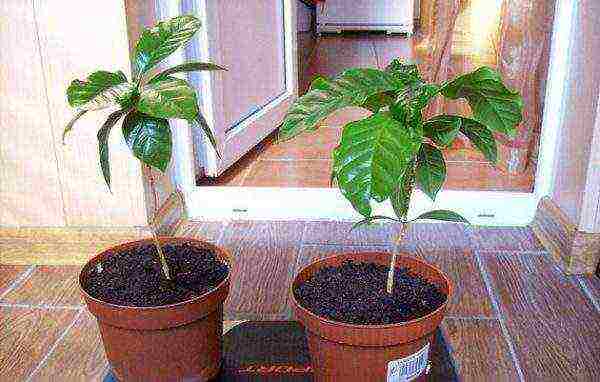
Landing
The very first step on the road to a luxurious and fruitful coffee tree in your garden is of great importance - planting, and, in some cases, replanting the plant. The most basic thing to remember is that the coffee tree grows exclusively in an acidic environment (that is, ph should be equal to
 Although today there are many interesting ornamental plants, many flower growers do not refuse the opportunity to have such an unusual representative of the flora world as the coffee tree in their home.However, not everyone dares to implement this idea, because they mistakenly believe that they will not be able to grow and care for this plant. In reality, everything is different, because with the appropriate approach, you can successfully grow a coffee tree at home.
Although today there are many interesting ornamental plants, many flower growers do not refuse the opportunity to have such an unusual representative of the flora world as the coffee tree in their home.However, not everyone dares to implement this idea, because they mistakenly believe that they will not be able to grow and care for this plant. In reality, everything is different, because with the appropriate approach, you can successfully grow a coffee tree at home.
The homeland of the coffee tree is Africa, and during its existence, coffee has been able to spread throughout the planet. Today it is not grown only in those regions where the climate is too harsh. If you provide him with proper care, then a couple of years will pass, and you will be able to taste a fragrant drink made from grains that you have grown with your own hands.
Features of seeds
If you finally decided for yourself that you want by all means to try a drink obtained from a home-grown coffee tree, then be prepared for the fact that you have to work hard... But first of all, you should be patient, since a lot of time will pass before the fruit appears. In addition, you should create suitable temperature conditions for the coffee tree so that it can grow and develop well.
When the grains of this plant are in the ground, the pot must be moved to a lighted place, where the temperature must be maintained at a level of at least 20 degrees. By creating such conditions, you will speed up the process of seed germination.
When growing coffee, keep in mind that any outside interference is only harmful. Therefore, you should minimize the amount of trimmings. It is best to skip this operation altogether unless the plant has exceeded your size expectations. It should be borne in mind that the coffee tree blooms in a completely different way from the usual plants for an ordinary grower. The uniqueness of the coffee tree lies in the fact that for the formation of berries flowers do not require pollination.
Before sowing a ripe berry, you need to prepare it by removing the pulp and rinsing it with water. Next, you need a weak solution of potassium permanganate, in which it is placed for half an hour. After that, you must immediately sow the grain in the ground.
Soil features
Even experienced flower growers cannot always answer the question of what should be the care of a coffee tree. There are many factors to consider here, among which the quality of the soil is of particular concern. It is best to use a mixture that contains many different elements that will enhance its natural acidity.
Depending on the phase of the plant's life cycle, use soil mixtures of different composition:
-
 A substrate for sowing seeds and sprouts. To prepare it, you need to take leafy earth and river sand, thanks to which moisture can easily be absorbed into the soil. Before planting, it is imperative to sterilize the substrate. This is done by placing it in a water bath, where it should sit for at least 5 minutes. During sowing, the seeds are laid flat on the soil surface. If all the recommendations were followed, then in about 1.5 months the seeds will begin to hatch. After waiting for the formation of the first leaves, it is necessary to think about transplanting the seedlings into a soil more suitable for growth. However, keep in mind that at the initial stage of the plant's life, transplants will have to be carried out every year until the plant reaches the age of 3 years. In the future, the frequency of transplants is reduced to once every two to three years.
A substrate for sowing seeds and sprouts. To prepare it, you need to take leafy earth and river sand, thanks to which moisture can easily be absorbed into the soil. Before planting, it is imperative to sterilize the substrate. This is done by placing it in a water bath, where it should sit for at least 5 minutes. During sowing, the seeds are laid flat on the soil surface. If all the recommendations were followed, then in about 1.5 months the seeds will begin to hatch. After waiting for the formation of the first leaves, it is necessary to think about transplanting the seedlings into a soil more suitable for growth. However, keep in mind that at the initial stage of the plant's life, transplants will have to be carried out every year until the plant reaches the age of 3 years. In the future, the frequency of transplants is reduced to once every two to three years. - Soil intended for transplanting an adult plant. It is made on the basis of sour peat, sand, leafy earth, humus, charcoal and moss, which are taken in equal quantities. To save yourself from the tedious search for the above ingredients, you can buy them at a specialized flower shop. If you want a young shoot to quickly turn into a full-fledged tree, it is recommended to transplant it into a large pot.Then the root system will form inward, as a result, the plant will be able to take the maximum amount of nutrients from the soil.
Planting a coffee tree in a vegetative way involves preparation of cut cuttings... To do this, it is kept for 1-2 hours in a special solution. You can start planting only after you have prepared all the necessary components. Further, they already proceed directly to transplanting the plant into the ground, into which it must be buried no deeper than 3 cm.At the moment when the first leaves of the plant form, a new transplant can be carried out, in which all the same actions are carried out as in the case with sprouts grown directly from seeds.
Arabica coffee: home care
 When preparing for planting a potted Arabica coffee plant, you need to remember that it will feel most comfortable if it is provided enough light... In the hot tropics, coffee is always grown with shading. A slightly different approach should be taken when growing coffee at home: it is necessary to create maximum lighting for it, otherwise its deficiency will slow down the growth of the plant, and in some cases, a delay in fruiting may occur.
When preparing for planting a potted Arabica coffee plant, you need to remember that it will feel most comfortable if it is provided enough light... In the hot tropics, coffee is always grown with shading. A slightly different approach should be taken when growing coffee at home: it is necessary to create maximum lighting for it, otherwise its deficiency will slow down the growth of the plant, and in some cases, a delay in fruiting may occur.
In winter, it is recommended to keep the flower on the warmest southern side. Although it should be remembered here that the temperature should not drop below 15 degrees. Particularly need to be careful on cold and cloudy days, when you need to use next to the plant. fluorescent lamps... With its help, you can fully satisfy the needs of the coffee flower for light and warmth.
The whimsicality of the flower is manifested in the fact that the optimal lighting mode for it must be maintained constantly for a long time. If you try to turn the tree, it will only help you get beautiful leaves. In this case, you are likely to be left without a long-awaited harvest. It is recommended to protect the coffee tree from direct sunlight; it is not advisable to keep it on the north side, where it will receive the minimum amount of light.
In the warm season, when the sun is especially hot, you will have to regularly water your coffee using settled water at room temperature... To maintain optimal humidity, you will have to take care of the leaves, in respect of which it is desirable to spray.
If you are going to move the pot to another location, you first need to prepare for the operation.
Within a few weeks, the plant should grow wrapped in gauze. This will provide diffused lighting for it. Thanks to this, it will be better able to get used to the new lighting. In the process of developing the coffee tree, transplants will have to be carried out, which is a fairly simple event and does not require special skills. The main thing is to strictly follow the recommendations for plant care.
Watering
Watering is very important for the coffee tree..
- special attention should be paid to the quality of the water: its composition should be free of lime impurities, which can cause serious harm to the root system;
- you also need to monitor the level of soil acidity. In order to maintain it, it is useful to add a few drops of vinegar or citric acid crystals to the settled water, which is used for irrigation. Although coffee reacts positively to moisture, the level of humidity in the air should not be too high;
- dressings are also effective, which are recommended to be carried out at least once every 1.5 months. Mineral liquid fertilizers are best suited for this, which stimulate the formation of new shoots, and with this the plant will receive all the nutrients important for normal development.
Food
 For the normal development of coffee it is not enough to feed in the spring.Especially you need to be careful with the plant at the stage of flower formation, since in this phase coffee needs more nitrogen and phosphorus. You can provide them to the plant with the help of ordinary horn shavings or bone meal.
For the normal development of coffee it is not enough to feed in the spring.Especially you need to be careful with the plant at the stage of flower formation, since in this phase coffee needs more nitrogen and phosphorus. You can provide them to the plant with the help of ordinary horn shavings or bone meal.
Keep in mind that the average person, without special tools, is not able to find out what level of acidity the soil used to grow coffee has. Therefore, in order to avoid difficulties when caring for coffee, it is recommended to seek help from a specialist at a flower shop so that he can suggest the most suitable feeding. If you are limited in financial resources, then you can use the available fertilization option. It could be common moss found in woodland areas.
Applying the right fertilizer at the right time will stimulate the growth of the coffee, which is very important to you as you expect the coffee tree to increase its bushiness. To do this, you will have to regularly pinch the side shoots. At the first signs of drying of some part of the plant, it is necessary to remove them at the base of the covering leaf petiole.
Difficulties to face
 Proper coffee maintenance involves controlling the acidity of the soil. Otherwise, the plant will react to this by losing its usual dark green color of the leaves, a glossy shade, as a result of which they will become discolored. Gradually, you can observe how the leaves begin to turn yellow, and after a while the plant can completely dry out if it is not provided with the required amount of fresh air. Isn't good for coffee and high humidity in the room, as this provokes leaf rot, often causing serious illness, which subsequently takes a long time for the coffee to recover.
Proper coffee maintenance involves controlling the acidity of the soil. Otherwise, the plant will react to this by losing its usual dark green color of the leaves, a glossy shade, as a result of which they will become discolored. Gradually, you can observe how the leaves begin to turn yellow, and after a while the plant can completely dry out if it is not provided with the required amount of fresh air. Isn't good for coffee and high humidity in the room, as this provokes leaf rot, often causing serious illness, which subsequently takes a long time for the coffee to recover.
Before growing coffee at home, it is useful to discuss important points with a professional who can talk about ways to protect against the most common diseases and pests:
- spider mite;
- scabbards;
- mealybug;
- aphids;
With this information, you can easily create the most optimal growing conditions, and this will increase your chances of getting fragrant fruits in a couple of years.
Conclusion
 Having gained some experience in growing simple ornamental plants, some of the florists probably had a desire to grow coffee at home. It is not worth giving up this idea, since it is quite feasible. Although this the process will take a long time, however, with proper care of the tree in a couple of years, you can get aromatic coffee fruits grown by your own hands. Therefore, if you are not afraid of difficulties and are ready to fight diseases, then after receiving theoretical training on the basics of growing a coffee tree in indoor conditions, you can get down to business.
Having gained some experience in growing simple ornamental plants, some of the florists probably had a desire to grow coffee at home. It is not worth giving up this idea, since it is quite feasible. Although this the process will take a long time, however, with proper care of the tree in a couple of years, you can get aromatic coffee fruits grown by your own hands. Therefore, if you are not afraid of difficulties and are ready to fight diseases, then after receiving theoretical training on the basics of growing a coffee tree in indoor conditions, you can get down to business.

This graceful and beautiful tree, covered with many oval leaves with a small pointed end and a slightly wavy edge, was brought to Europe in the seventeenth century. They began to grow it in apartments much later. Let's see how you can grow the Arabica coffee tree and what is the home care.
Arabica coffee tree: home care
Its dark green large shiny leaves, fragrant white flowers, bright cherry-sized fruits have always attracted attention. From such a description, it is rather difficult to guess what kind of plant it is not easy. Even seeing him, not everyone will understand. But if you put a cup of aromatic coffee on the table as a hint, it may be easier to guess.
Read the article on how you can try growing tomatoes in a pot on a windowsill.
Coffee tree: description
The entire trunk of the coffee is covered with a light brownish bark.Every year, with the onset of early spring, small white flowers appear on the coffee tree, which are located at the base of the trunk, in the places where the leaves attach. This place is called the leaf axils. After the flowers, very small greenish fruits appear, which gradually turn red, and then brown with a red tint.
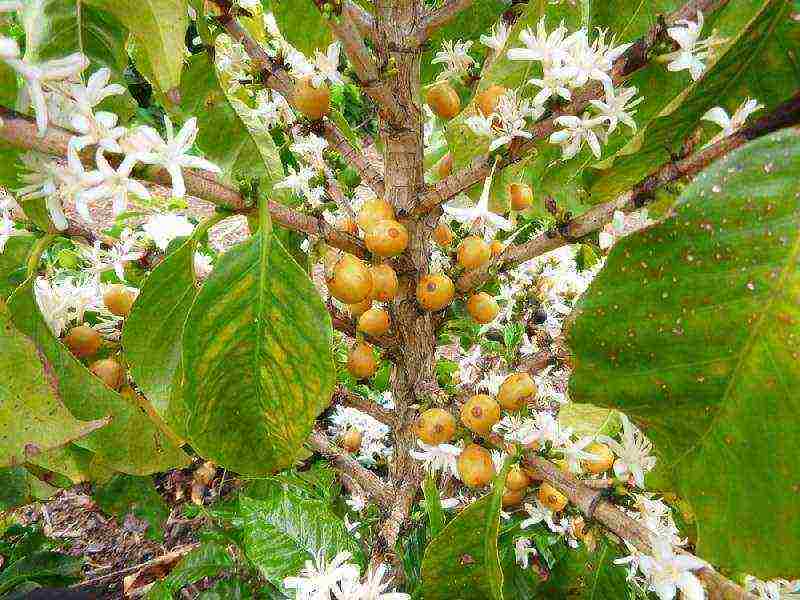
Quite often, on the branches of a tree there can be both fruits and flowers at the same time. Each coffee fruit contains two coffee beans.
Under natural conditions, this culture reaches 5 or 6 meters. In apartments, coffee usually grows up to two meters. Arabian coffee is more unpretentious in terms of care and growing conditions, and therefore it is more often grown. Liberian and Brazilian species of this plant can also be grown.
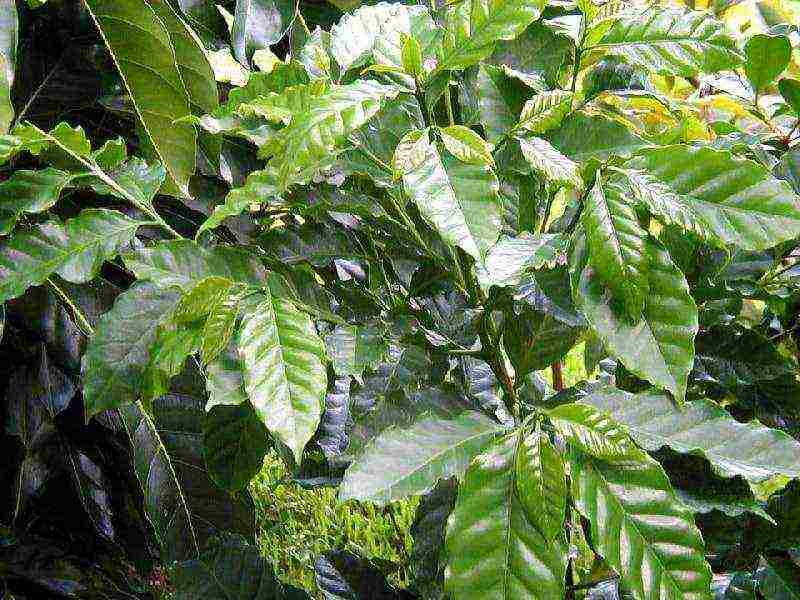
A place
A suitable place for a coffee tree or coffee can be an office or a city apartment with their usual temperature regime, when it is warm in summer and cool in winter. The lower temperature limit is about thirteen degrees. Coffee is a light-loving culture; it will not bloom and bear fruit at the northern window or in the back of the room without additional lighting. The optimal winter temperature is 15-16 degrees, but good illumination is required.
Illumination and care
On real plantations, coffee trees are shaded from the scorching sun, but in our latitudes, and even indoors, this should not be done.
Only young plants up to one and a half to two years protect from the scorching sun, since it leaves severe burns.
If the conditions are suitable and the care does not disappoint (by the way, it is simple), the plant will delight in its appearance, bloom and bear fruit. And on occasion, you can treat guests to Arabica or Robusta from your own "plantation".
How to transplant Arabica coffee?
It is necessary to transplant the coffee tree for up to three years annually, and then every 2-3 years. The diameter of the container for adult specimens is increased each time by five to six centimeters.
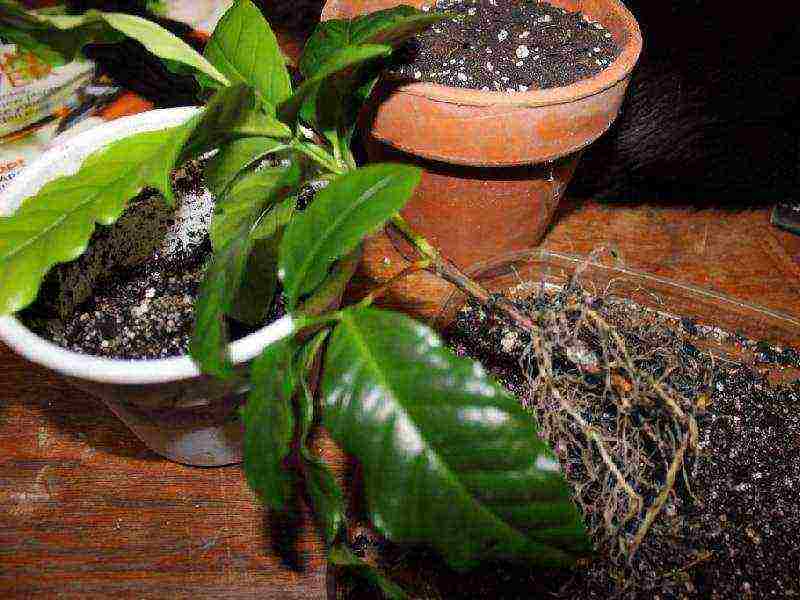
Soil for Arabica coffee
Soil for a coffee tree can be made by yourself, prepared from the following ingredients: leafy earth or humus - 3-4 parts, high moor peat and sand in one part, a little ash and chopped sphagnum. Good drainage is essential at the bottom of the pot. Expanded clay is usually used for it. Small fraction - for young plants, and medium and large - for adults.
How to water a coffee tree at home?
Watering a coffee tree or bush occurs according to the classic scheme: generously in summer, moderate in winter, avoiding waterlogging and drying out of the soil. Also, the plant is sprayed and, sometimes, even have a shower. Watered with soft water, ideally thawed or rainwater.
The plant loves moist air. In the fight against dryness, all methods are good: regular spraying, a tray with constantly wet expanded clay, a container with water next to the tree.
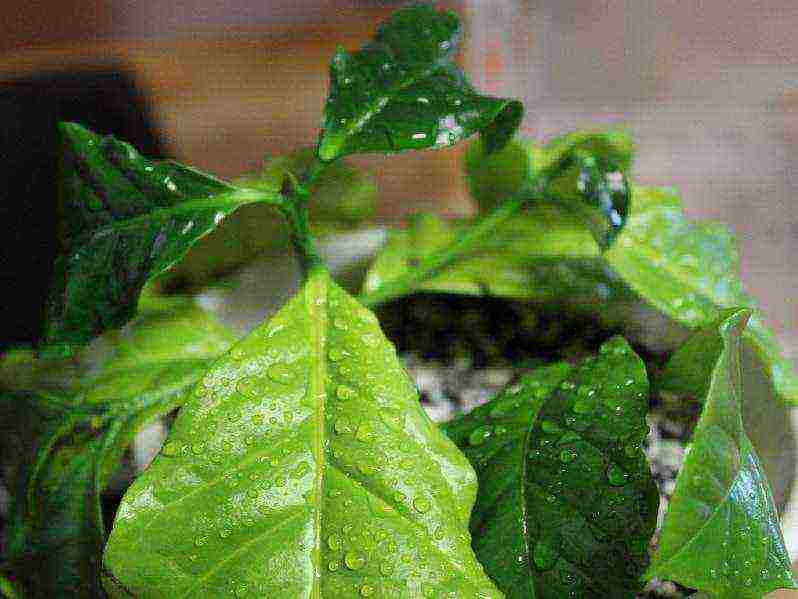
How to fertilize a coffee tree at home?
During the period of intensive growth, feeding is carried out once every fifteen days. It is better to apply fertilizer in the form of a solution, but before feeding it is imperative to water the plant.
Reproduction of the coffee tree at home
The easiest way to get homemade coffee is to buy seedlings from a flower shop. Are you not looking for easy ways or do you love experiments? We offer two ways to choose from: grow a tree from a seed or a cutting.
Cutting a coffee tree at home
From the cutting it is faster, however, for this you need to have in mind a plant from which you will cut a branch. Usually, the upper part of the shoot with two pairs of leaves is chosen for this.
The cut at the bottom is made oblique, and the distance from the lower pair of leaves should be about 2 or 3 cm.Around this cut, several shallow longitudinal scratches are made on the bark. Then the cuttings are kept for three to four hours in a solution of succinic acid or any other stimulant for root formation.The choice of such substances in a store or garden center is quite large.
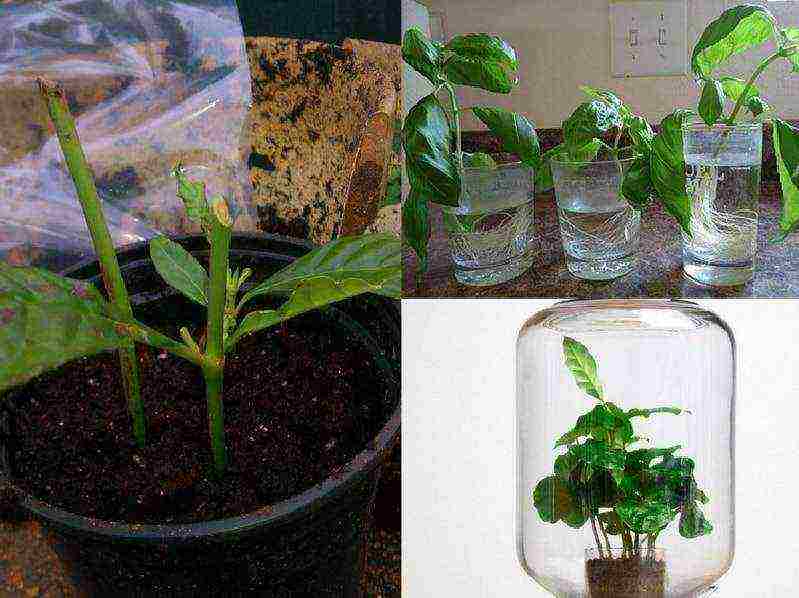
They are planted strictly vertically, so that the bases of the lower leaves are in the ground, and covered with a plastic bag with slots. Then they are kept in diffused light, but at the same time they are periodically sprayed. The soil temperature should be at least 25-27 degrees. Rooting lasts from a month to one and a half months.
How to plant coffee tree seeds at home?
The seeds for germination must be fresh, and, of course, not fried. Interestingly, some people manage to germinate even store-bought grains. Before planting, it would be desirable to soak them in an epin solution. Then the pot with the seeds sown in moist soil is placed on a warm sunny windowsill.
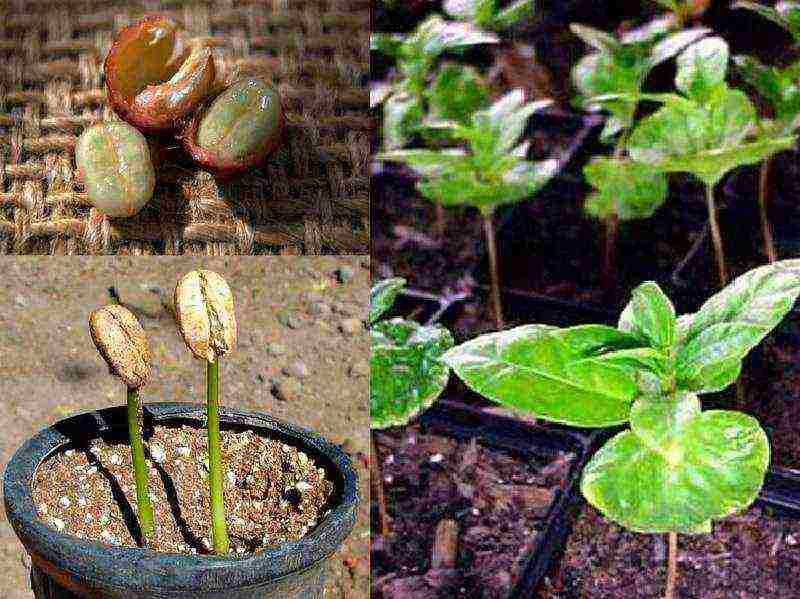
What conclusion can be drawn? The Arabica coffee tree is an interesting crop and home care is not difficult. Fragrant, attractive flowers will decorate your apartment. We have covered all the most important things about the propagation of the coffee tree by cuttings and seeds.


